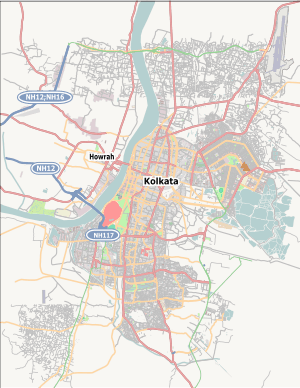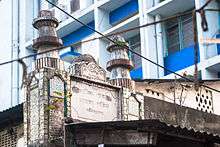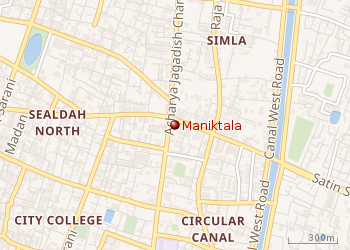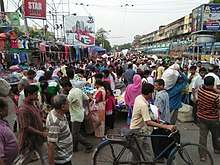Maniktala
Maniktala is a residential area of North Kolkata, in Kolkata district, West Bengal, India.
Maniktala | |
|---|---|
Neighbourhood in Kolkata (Calcutta) | |
Maniktala crossing with Market and Clock Tower | |
 Maniktala Location in Kolkata | |
| Coordinates: 22.585°N 88.375°E | |
| Country | |
| State | West Bengal |
| City | Kolkata |
| District | Kolkata |
| Metro Station | Girish Park and Sealdah |
| Municipal Corporation | Kolkata Municipal Corporation |
| KMC wards | 15, 16, 27, 28 |
| Elevation | 36 ft (11 m) |
| Population | |
| • Total | For population see linked KMC ward pages |
| Time zone | UTC+5:30 (IST) |
| PIN | 700004, 700006, 700009 |
| Area code(s) | +91 33 |
| Lok Sabha constituency | Kolkata Uttar |
| Vidhan Sabha constituency | Maniktala, Jorasanko and Beleghata |
Etymology
The tomb of Manik Pir is located in lane near Maniktala crossing.[1] Some people say, the neighbourhood is named after Manik Pir.

Others say, Manik pir (erst: Syed Husen Ud din shah) came from North India on early eighteenth century. But Maniktala, this name is also mentioned in a map of 1784. They says, the bodyguard of Nawab of Bengal Alivardi Khan, Manikchand Bose (erst : Manikram Bose) lives this place as caretaker of Calcutta (Ali Nagar) around from 1756. He was a wise, Compassionate man. That's why he was so popular to all people. From Manikchand this area is called Maniktala.
History
In 1889, the suburbs of old Calcutta were grouped in four municipalities. Maniktala formed the East Suburban Municipality. In the same year, Maniktala, Ultadanga and Beliaghata became 'fringe area wards' of Kolkata Municipal Corporation.[2] The Calcutta Municipal Act of 1923 brought about important changes. The adjacent municipalities of Cossipore, Chitpur, Maniktala and Garden Reach were amalgamated with Kolkata. Garden Reach was later taken out.[3][4]
Geography
 |
Location
Today's Maniktala crossing is the intersection of Vivekananda Road (Maniktala Main Road) and Acharya Prafulla Chandra Road (Upper Circular Road) — two main thoroughfares in North Kolkata. Beadon Street (Dani Ghosh Sarani/Abhedananda Road), one of the important streets of North Kolkata originates from Maniktala, ending in Nimtala Ghat. Amherst Street also starts nearby (Chaltabagan). Aurobindo Sarani crosses APC Road at Khanna crossing, Maniktala. Maniktala crossing connects Shyambazar, Kankurgachi, Rajabazar and Girish Park to Maniktala.[5]
Police district
Manicktala police station is part of the Eastern Suburban division of Kolkata Police. It is located at 20, Canal West Road, Kolkata-700006.[6]
Ultadanga Women police station covers all police districts under the jurisdiction of the Eastern Suburban division i.e. Beliaghata, Entally, Maniktala, Narkeldanga, Ultadanga, Tangra and Phoolbagan.[6]
Landmarks
The Central Blood Bank of West Bengal Government is located at the Maniktala crossing. So is one of oldest markets of Kolkata, the Maniktala Bazar, easily identified by the clock tower. Gouribari Badridas Jain Temple is also located nearby.
Economy
Daily markets

Maniktala market, along with Hatibagan, Sealdah, Lake Market and Gariahat markets, is amongst the largest markets in Kolkata.[7] "The vintage landmark of the clock tower in Maniktala helps to spot the interiors of this market well." Maniktala is famous for its fish market but is also popular for groceries and fresh vegetables. It is one of the best farmer's markets in Kolkata.[8] Maniktala Market at 187, Vivekananda Road is a private market spread over 3 acres. Vegetables, fruits, betel leaf, flowers, fish, meat, egg etc.are available. Maniktala Municipal Market is located at P-187, C.I.T. Road, Kankurgachi.[9] In Kolkata, every para (neighbourhood) has a machher bazar (fish market), but there are some big fish markets in different areas of the city: Howrah wholesale fish market, Gariahat, Sealdah and Maniktala. These markets "are famous not only for the wide variety of fishes they procure but also for their stellar quality. Prices depend on the fish you want. The staple ones are competitively priced. However, the special fishes such as Iilish, Chitol, Chingri can go for some ridiculous pricing. But that’s no deterrence for the fish lover who can’t do without it in his lunch!"[10][11] Maniktala market sets a sort of a bench-mark for the pricing.[12]
Transport
The Maratha Ditch was dug in 1742 and it was partly filled up in 1799 to create the Circular Road (now Acharya Prafulla Chandra Road).[13]
The construction of Vivekananda Road, by Calcutta Improvement Trust, was completed in 1928. It was a broad new road through a congested area and changed the complexion of the area. Many buses and auto-rickshaws ply along these roads.[14]
Electric tramcars were introduced in Calcutta in 1902. Tram lines were laid upto Rajabazar in 1910. The line along Upper Circular Road to Galiff Street came in 1941.[15] A new tram line was laid from Maniktala to Ultadanga in 1985. Now Kolkata tram route no. 18 serves Maniktala (via APC Road-Vivekananda Road/Maniktala Main Road).[16]
Culture
One of Kolkata's largest Durga Puja celebration, the Manicktalla Chaltabagan Lohapatty Durga Puja is celebrated in its vicinity.
External links
| Wikimedia Commons has media related to Maniktala. |
![]()
References
- Cotton, H.E.A., Calcutta Old and New, first published 1909/reprint 1980, Page 800, General Printers and Publishers Pvt. Ltd.
- Nair, P.Thankappan, The Growth and Development of Old Calcutta, in Calcutta, the Living City, Vol. I, p. 13, Edited by Sukanta Chaudhuri, Oxford University Press, 1995 edition.
- "A walk down memory lane". About Kolkata. KMC. Retrieved 16 February 2018.
- "Kolkata Municipal Corporation". Kolkata - a municipal history. KMC. Retrieved 16 February 2018.
- Google maps
- "Kolkata Police". Eastern Suburban Division. KP. Retrieved 5 March 2018.
- Bandopadhyay, Raghab, Calcutta’s Markets, in Calcutta, The Living City Vol II, Edited by Sukanta Chaudhuri, Page 118, First published 1990, 2005 edition, ISBN 0-19-563697-X
- "Maniktala Market, Farmers' Market". Yatra. Retrieved 11 April 2018.
- "Primary Hats/ Markets of District". Markets in Brief - Kolkata. West Bengal State Marketing Board. Archived from the original on 2 April 2018. Retrieved 11 April 2018.
- "How About a Sortie to a Fish Market in Kolkata?". Wheels On Our Feet. Retrieved 11 April 2018.
- "'Where the Fish is very Dear' - A Caricature of Kolkata's Relation with Fish". Cold Noon, 1 January 2018. Retrieved 11 April 2018.
- "Hilsa hurrah in markets – supply surge triggers price drop". The Telgraph, 31 August 2017. Retrieved 11 April 2018.
- Nair, P.Thankappan, The Growth and Development of Old Calcutta, in Calcutta, the Living City, Vol. I, edited by Sukanta Chaudhuri, pages 12-13, Oxford University Press, ISBN 978-0-19-563696-3.
- Chaudhuri, Sukanta, "Traffic and Transport in Calcutta", in "Calcutta, The Living City" Vol II, edited by Sukanta Chaudhuri, Page 151, First published 1990, 2005 edition, ISBN 0-19-563697-X
- Nair, P.Thankappan, Civic and Public Services in Old Calcutta, in Calcutta, the Living City, Vol. I, edited by Sukanta Chaudhuri, page 235, Oxford University Press, ISBN 978-0-19-563696-3.
- Chaudhuri, Sukanta, "Traffic and Transport in Calcutta", in "Calcutta, The Living City" Vol II, edited by Sukanta Chaudhuri, Page 155, First published 1990, 2005 edition, ISBN 0-19-563697-X